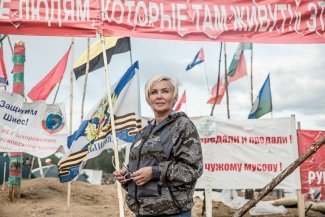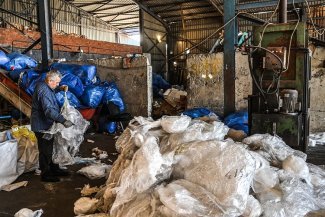Despite the difficult climate, the inhabitants of the Valbona valley get out to demonstrate against the destruction of Albania’s eco-system, like here in November 2017. The banner held by the protestors says “Hands off Valbona”.
Their movements are barely noticeable. On the banks of the River Cemi, the sheep that drink there seem to blend in with pebbles. In the imposing landscape of the Albanian Alps, these scenes appear timeless. Yet, just a few hundred metres away, imposing pipes are a reminder of the imminent threats to the ancestral way of life of the shepherds of northern Albania.
“Everyone is against the construction of the hydroelectric power station, but nobody does anything!”, Hana (not her real name) says bitterly. This mother, who has invested in trout farming near the small village of Tamara, can barely hide her desperation. While most people have heard about the plans concerning their river, few want to talk about it. In Albania, a small country traumatised by its totalitarian past, and where cronyism is still rife, it is not easy to speak out.
The brand new road, completed two years ago, is raising hopes in the Kelmend Mountains. Long abandoned to its poverty and isolation, the local population sees potential sources of income and a way to gain a foothold in the booming tourist industry. Tamara’s small pedestrian main street has been renovated and cafés with new facades are keen to welcome their summer visitors.
They are expecting a record number this year. Albania’s bad media image is no longer putting them off and the economic decision-makers are dreaming of turning the country into a new Croatia. But they do not seem to value the natural treasures the tourist agencies are vaunting.
"A tsunami of dams"
Like hundreds of rivers in the Balkans, the clear waters of the Cemi that dazzle visitors have not been spared the race for blue gold. “We have found plans for nearly 3,000 hydro-electric power stations between Slovenia and Greece,” says Ulrich Eichelmann, founder of the NGO RiverWatch. With many local staff reporting back to them, the Viennese organisation is fighting against this concrete invasion of south-eastern Europe.
The explosion in the number of these projects can be explained first of all by the new economic realities. “In the years following the wars in Yugoslavia, the local political situation was considered too volatile by investors,” says Eichelmann. “This has changed and hydroelectricity has been driven by recent debates on climate change with the need to develop so-called ‘renewable’ energies.”
The environmental activist also points to the flaws in today’s Balkan countries. “Add to the corruption a rather inexperienced civil society and an often weak rule of law, and you get the ideal framework for a tsunami of dams.” These projects, which are generally not very transparent, affect even the most protected areas in the region.
A few kilometres from Tamara as the crow flies, the Valbona National Park has been disfigured by several construction projects. For many months now, locals have been trying many different ways to mobilise to save their valley. They argue in favour of their local style of tourism that is respectful of nature and has allowed many to improve their daily lives.
In early June 2018, the situation became critical, as Dardan Metaliaj, a young tour guide, told Equal Times. “Explosions related to the building works have led to rock falls on our land and close to our homes. People working in the fields are traumatised.” To protest, residents occupied the main road before being joined and supported by tourists.
In a country still predominantly rural, the pristine water of the rivers is part of the daily lives of thousands of people who live along their banks. Is the link between the local population and their natural environment about to be broken?
“We no longer have access to water for our farmland, and even drinking water is a problem because the construction sites are constantly pumping,” says Dardan. “Despite the threats, we will continue to demonstrate, because this is about our life.” Back in the village after four years in France, Dardan does not want to be forced to emigrate again, as so many young people from the Balkans are doing.
The Valbona National Park is by no means the only protected area in the region threatened by the race to produce electricity. As hot spots of global biodiversity, the Balkans are home to one of the richest ecosystems on the continent, thanks to a dense network of preserved rivers. But not even this can curb the financial appetites of the energy sector.
Effective mobilising
The NGO Bankwatch-CEE notes that "the current system of protected areas does not deter investors or financiers”. Places bearing the European Natura 2000 heritage label or the national parks label are also threatened by construction sites. And that is often supported financially by the European taxpayer. In a report published in March 2018, the NGO noted that the major European public development banks have provided financial support to 37 hydroelectric power stations located in these fragile environments.
In this context, and despite the droughts of recent years, small, low-capacity plants are multiplying. As they usually do not require any environmental impact study, they could have a catastrophic impact.
At least that is what scientists at the University of Graz are warning about this sudden rash of dams. Their studies show that many endemic species could disappear, including one in ten European species of fish.
At this time of climate commitments and the rise of renewable energies, the defenders of the Balkan rivers want to expose "the truth about dams" to the world.
"To argue that hydroelectricity is green energy, just because it does not emit CO² is ridiculous," says Ulrich Eichelmann. "Hydroelectricity is the worst source of energy in terms of its impact on nature. It completely ruins our livelihoods."
Although the works are progressing, the opponents of the dams have reason to be optimistic. The efforts of local residents and environmental activists to protect the "blue heart of Europe" are paying off.
In Macedonia’s Mavrovo National Park, the European Bank for Reconstruction and Development (EBRD) withdrew from a major project following the strong mobilisation of community actors. Further north, in Bosnia, women from the village of Kruščica occupy a dam site, day and night. In mid-June, the Tirana court ruled in favour of the activists, ordering the suspension of work in the Valbona National Park.











